Iowa is a land of cornfields, prairie flowers, and even some surprisingly thick forests. Within those diverse landscapes, many different species of snakes make their homes. Because most are snakes are shy, Iowans may not be aware of all the serpents who share their state. Here are 28 snakes found in Iowa.

The 28 Snakes Found in Iowa
1. Timber Rattlesnake

| Species: | C. horridus |
| Longevity: | 10 – 20 years |
| Good to own as a pet?: | No |
| Legal to own?: | Not in Iowa |
| Adult size: | 44 – 50 inches (112 – 127 cm) |
| Diet: | Carnivorous |
One of 5 venomous snakes found in Iowa, the Timber rattlesnake lives in forest habitats. Identify them by their triangular head, slit-like pupils, and black tails with light-colored rattles.
2. Prairie Rattlesnake
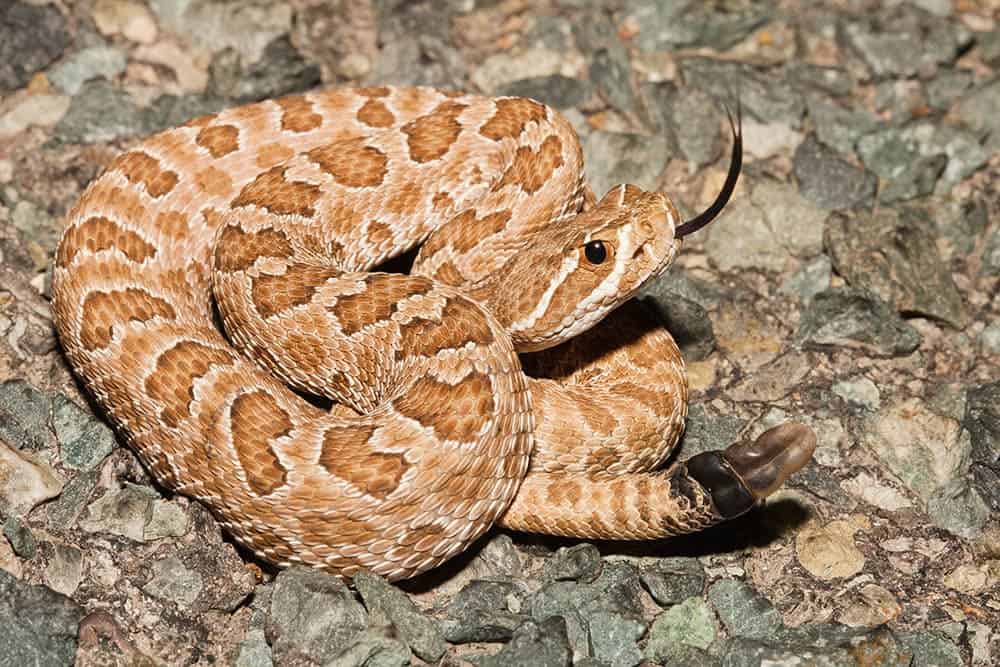
| Species: | C. viridis |
| Longevity: | 16 – 20 years |
| Good to own as a pet?: | No |
| Legal to own?: | Not in Iowa |
| Adult size: | 35 – 45 inches (89 – 114) cm |
| Diet: | Carnivorous |
Another venomous Iowa snake, Prairie rattlesnakes are also an endangered species. They are tan, brown, or green with brown splotches and two lines on the side of their heads.
3. Eastern Massasauga Rattlesnake
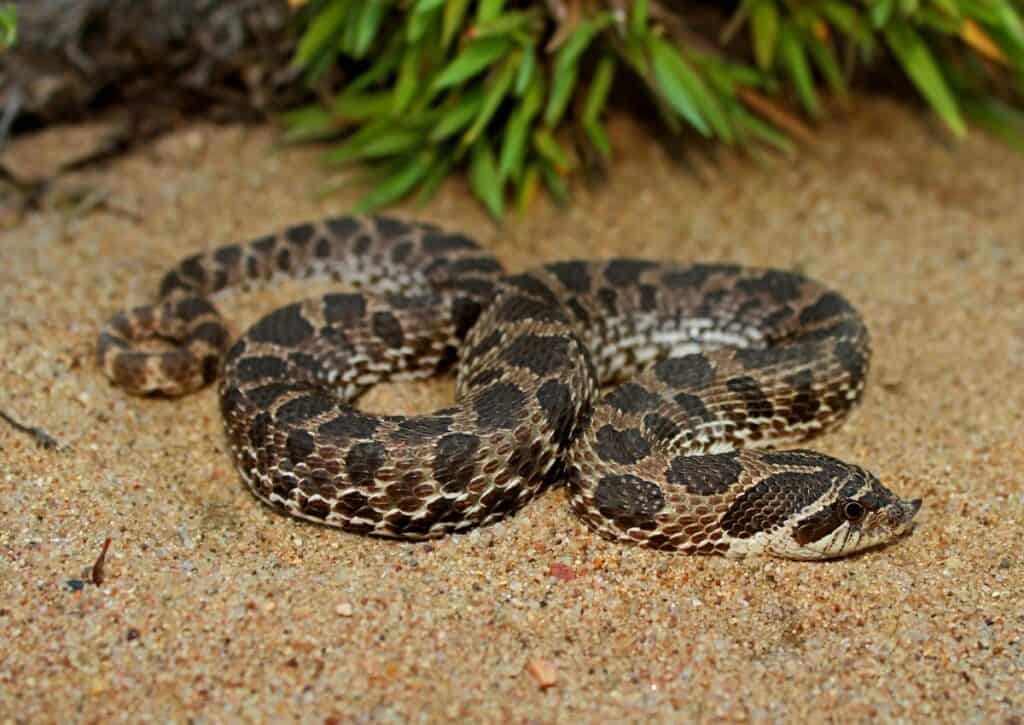
| Species: | S. cattenatus |
| Longevity: | 14 years |
| Good to own as a pet?: | No |
| Legal to own?: | Not in Iowa |
| Adult size: | 18.5 – 30 inches (47 – 76 cm) |
| Diet: | Carnivorous |
Eastern Massasauga rattlesnakes are a venomous, endangered species in Iowa. Theyʻre gray or gray-brown with dark blotches on the back, cat-like pupils, and a triangle-shaped head. Eastern Massasaugas are threatened by the loss of their wetland habitat.
4. Copperhead

| Species: | A. contortrix |
| Longevity: | 18 years |
| Good to own as a pet?: | No |
| Legal to own?: | Not in Iowa |
| Adult size: | 24 – 36 inch (61 -91 cm) |
| Diet: | Carnivorous |
Another venomous snake found in Iowa, Copperheads are light to dark copper with darker blotches. While the species isnʻt threatened overall, they are endangered in Iowa, which is at the very northern edge of their range.
5. Western Massasauga Rattlesnake

| Species: | S. tergeminus |
| Longevity: | 20 years |
| Good to own as a pet?: | No |
| Legal to own?: | Not in Iowa |
| Adult size: | 17 – 39 inches (43 – 99 cm) |
| Diet: | Carnivorous |
The final venomous snake in Iowa is the Western Massasauga rattlesnake. Look for the triangular head and slit-like pupils to tell the difference between this and similar, non-poisonous snakes. This rattlesnake is only found in a small area of southwestern Iowa.
6. Northern Watersnake
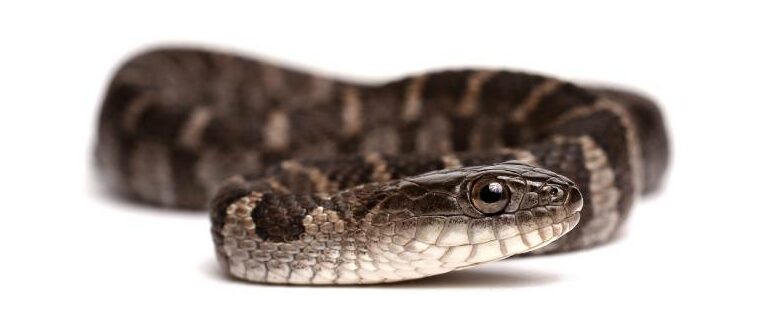
| Species: | N. sipedon |
| Longevity: | 9 years |
| Good to own as a pet?: | Yes |
| Legal to own?: | Not in Iowa, protected |
| Adult size: | 24 – 44 inches (61 – 112 cm) |
| Diet: | Carnivorous |
The most common water snake found in Iowa, the Northern watersnake is found along rivers, ponds, and lakes. They can swim, dive, and stay underwater for as long as 90 minutes! This species is often mistaken for the venomous water moccasin, which is not found in Iowa.
7. Diamondback Water Snake
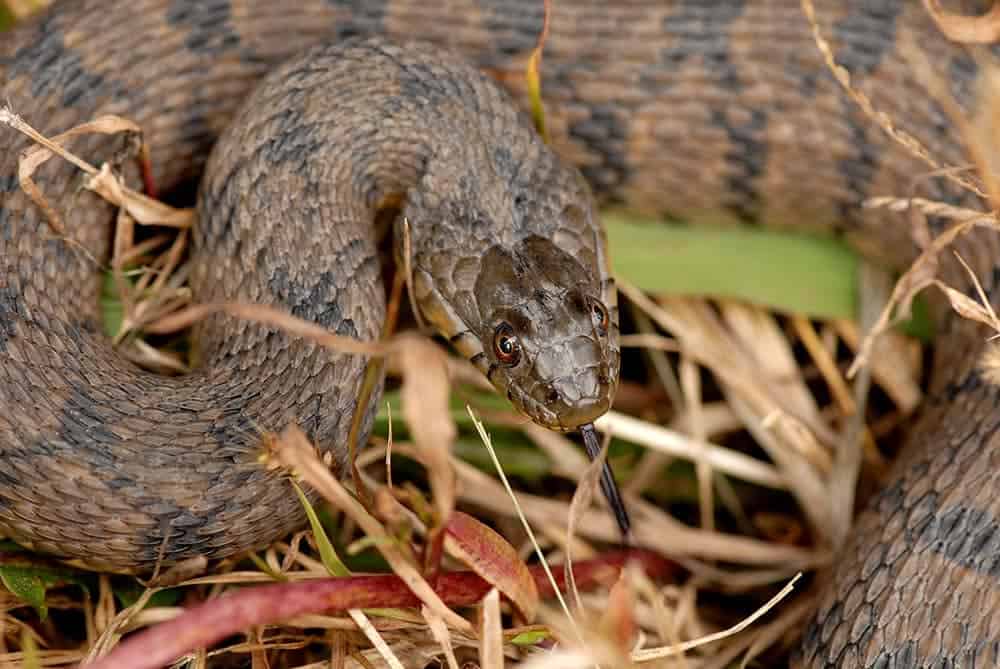
| Species: | N. rhombifer |
| Longevity: | 9 years |
| Good to own as a pet?: | No |
| Legal to own?: | Not in Iowa, protected |
| Adult size: | 30 – 48 inches (76 – 122 cm) |
| Diet: | Carnivorous |
The markings of this water snake look more like a chain than diamonds. These snakes live in wetlands and streams of southeast Iowa. They are often mistaken for venomous water moccasins due to their similar appearance and irritable nature.
8. Plainbelly Water Snake
| Species: | N. erythrogaster |
| Longevity: | 8 – 15 years |
| Good to own as a pet?: | Yes |
| Legal to own?: | Not in Iowa, endangered |
| Adult size: | 30 – 48 inches (76 – 122 cm) |
| Diet: | Carnivorous |
Plainbelly water snakes are one of the rarest snakes in the state, found only in southeastern Iowa near the Mississippi River. These water snakes eat prey including fish, crayfish, and baby turtles.
9. Grahamʻs Crayfish Snake
| Species: | R. grahamii |
| Longevity: | unknown |
| Good to own as a pet?: | No |
| Legal to own?: | Yes |
| Adult size: | 18 – 28 inches (46 – 71 cm) |
| Diet: | Carnivorous |
The smallest water snake found in Iowa, this species is also the shyest and the only one with stripes. These snakes eat mainly crayfish and spend their winters snuggled into empty crayfish burrows.
10. Western Worm Snake

| Species: | C. vermis |
| Longevity: | 4 years |
| Good to own as a pet?: | Yes |
| Legal to own?: | Not in Iowa, threatened |
| Adult size: | 7.5 – 11 inches (19 – 28 cm) |
| Diet: | Carnivorous |
Worm snakes live in wooded areas in southern Iowa and eat mostly earthworms. They burrow into the ground to escape danger and hot weather.
11. North American Racer
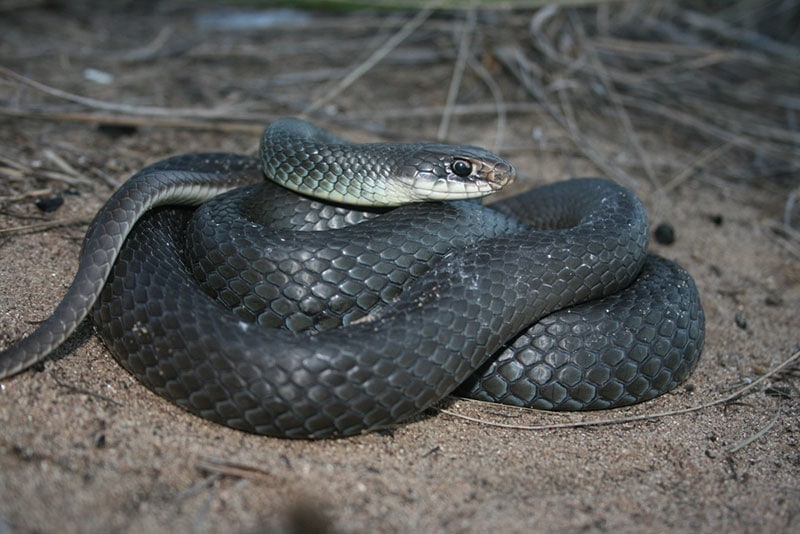
| Species: | C. constrictor |
| Longevity: | 10 years |
| Good to own as a pet?: | No |
| Legal to own?: | Not in Iowa, protected |
| Adult size: | 23 – 50 inches (58 – 127 cm) |
| Diet: | Carnivorous |
Large and fast, North American racers are found in grasslands and forest edges. Loss of habitat makes them a threatened and protected species in Iowa. Speedy hunters, they eat nearly anything they can catch, including rodents and other snakes.
12. Ringneck Snake

| Species: | P. punctatus |
| Longevity: | 10 – 20 years |
| Good to own as a pet?: | No |
| Legal to own?: | Not in Iowa, protected |
| Adult size: | 10 – 15 inches (25 – 38 cm) |
| Diet: | Carnivorous |
Ringneck snakes are solid brown, black, or slate with an orange or yellow ring around their neck. They are found in wooded habitats, often under logs or rocks.
13. Plains Hog-nosed Snake

| Species: | H. nasicus |
| Longevity: | 9 – 19 years |
| Good to own as a pet?: | Yes |
| Legal to own?: | Not in Iowa, endangered |
| Adult size: | 15 – 39 inches (38 – 99 cm) |
| Diet: | Carnivorous |
This species is endangered in Iowa because their specific habitat, open sand prairies, and dunes, are disappearing quickly. When threatened, these snakes puff their heads and necks up like a cobra to scare away enemies.
14. Eastern Hog-nosed Snake
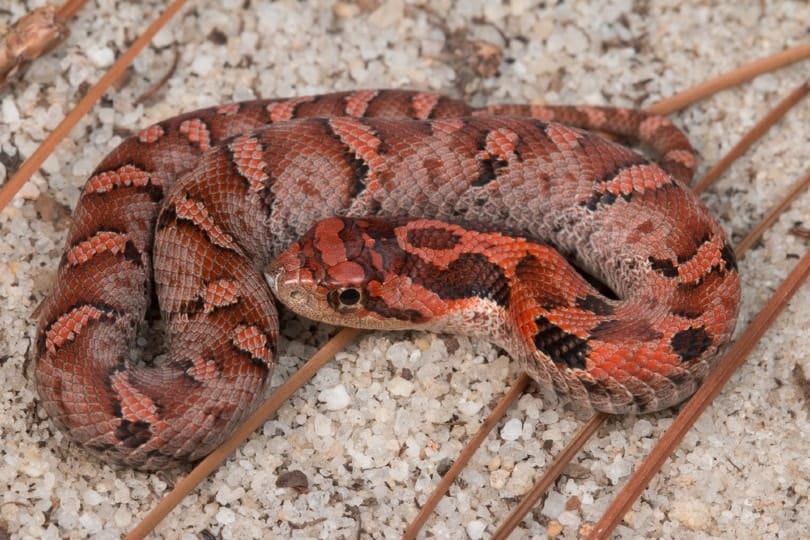
| Species: | H. platirhinos |
| Longevity: | 12 years |
| Good to own as a pet?: | Yes |
| Legal to own?: | Yes |
| Adult size: | 24 – 46 inches (61 – 117 cm) |
| Diet: | Carnivorous |
Able to live in a variety of habitats from woods to grasslands, the Eastern Hog-nosed snake has a more stable population than the Plains hognose. They dig their own burrows into the ground, often using them to survive the cold Iowa winters.
15. Prairie Kingsnake
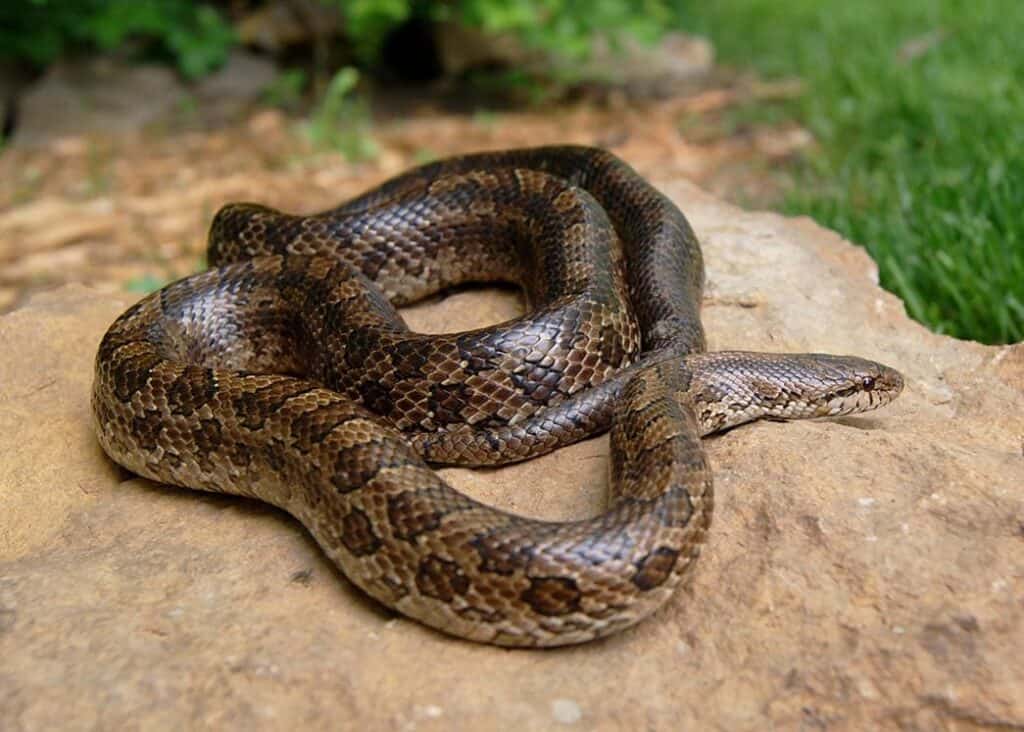
| Species: | L. calligaster |
| Longevity: | 12 – 16 years |
| Good to own as a pet?: | Yes |
| Legal to own?: | Captive-bred only |
| Adult size: | 30 – 42 inches (76 – 107 cm) |
| Diet: | Carnivorous |
Prairie kingsnakes kill their prey by constricting and are beneficial to humans because they help control rodents. These snakes are common in southern Iowa, found in open fields, prairies, and forest edges.
16. Speckled Kingsnake
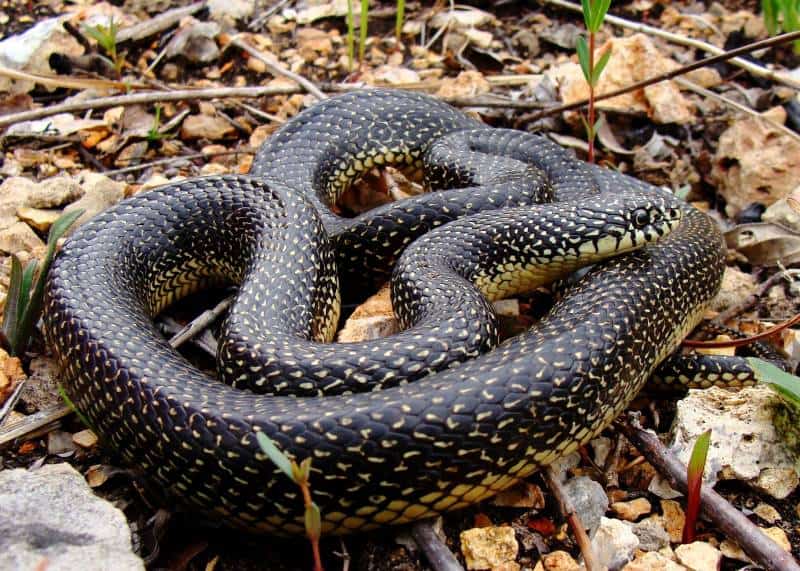
| Species: | L. holbrooki |
| Longevity: | 20 years |
| Good to own as a pet?: | Yes |
| Legal to own?: | Captive-bred only |
| Adult size: | 36 – 48 inches (91 – 122 cm) |
| Diet: | Carnivorous |
These snakes are nicknamed “salt and pepper snakes” due to their unique appearance. Black with spots on each scale, speckled kingsnakes are found in a variety of habitats. They are immune to venomous snake bites and often eat them, in addition to rodents, birds, and other prey.
17. Eastern Milksnake
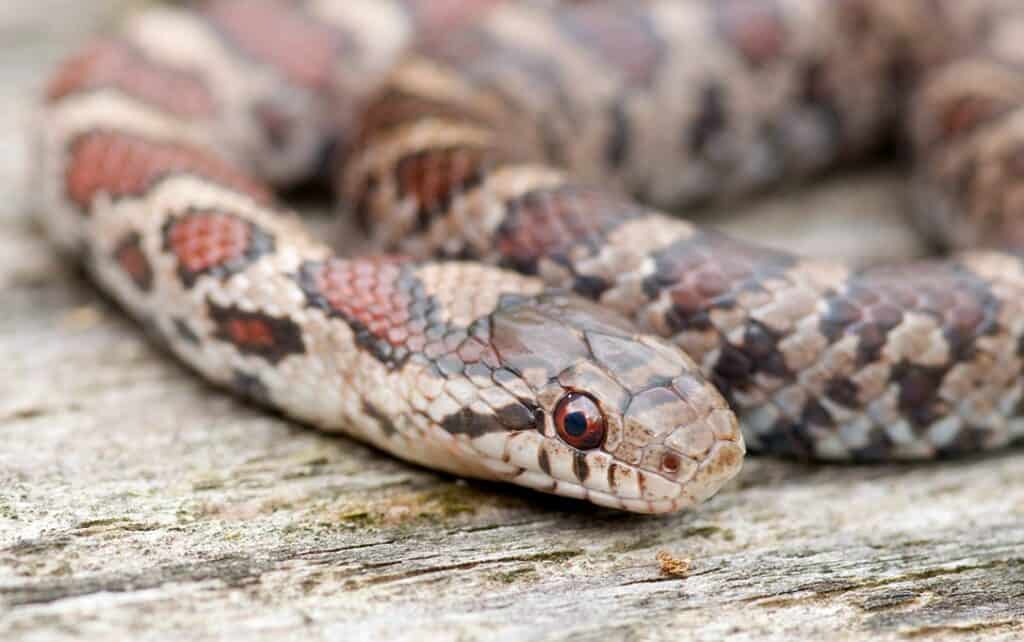
| Species: | L. triangulum |
| Longevity: | 12 – 20 years |
| Good to own as a pet?: | Yes |
| Legal to own?: | Captive-bred only |
| Adult size: | 24 – 52 inches (61 – 132 cm) |
| Diet: | Carnivorous |
Eastern milk snakes are found in rocky areas on prairies and farms. They vary in color but all have black-bordered splotches. Rodents are their usual prey and they are shy snakes, not often observed by humans.
18. Smooth Green Snake
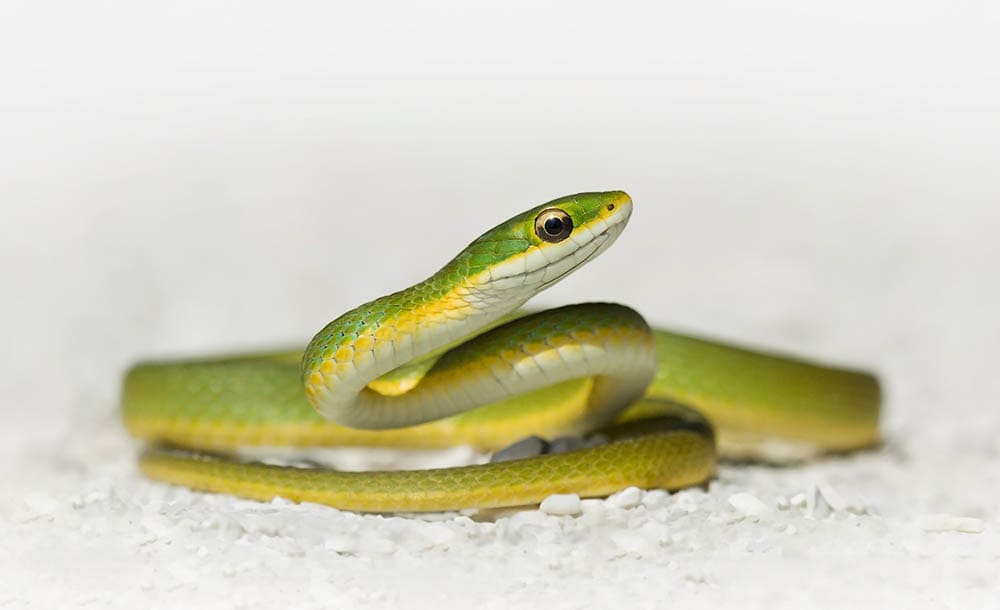
| Species: | O. vernalis |
| Longevity: | 6 years |
| Good to own as a pet?: | No |
| Legal to own?: | Not in Iowa, protected |
| Adult size: | 12 – 22 inches (30 – 56 cm) |
| Diet: | Carnivorous |
Thereʻs no mistaking these snakes with any other in Iowa! Bright green all over with yellow or cream bellies, smooth green snakes are found in meadows and forest clearings. They primarily eat insects, unusual among snake species.
19. Western Rat Snake
| Species: | P. obsoletus |
| Longevity: | 10 – 15 years |
| Good to own as a pet?: | Yes |
| Legal to own?: | Captive-bred only |
| Adult size: | 40 – 74 inches (101 – 188 cm) |
| Diet: | Carnivorous |
One of the largest snakes in Iowa, rat snakes are usually black with white throats. They live in the deep woods. When startled, these snakes shake their tails, causing a rattling sound that often leads to them being mistaken for rattlesnakes.
20. Western Fox Snake

| Species: | P. ramspotti |
| Longevity: | 17 years |
| Good to own as a pet?: | Yes |
| Legal to own?: | Captive-bred only |
| Adult size: | 36 – 56 inches (91 – 142 cm) |
| Diet: | Carnivorous |
Beautifully marked, Fox snakes look similar to copperheads, often leading to a fatal case of mistaken identity. Check the head and pupil shape to distinguish between the two species. These adaptable snakes are often found near human habitats, including in cities.
21. Gopher Snake
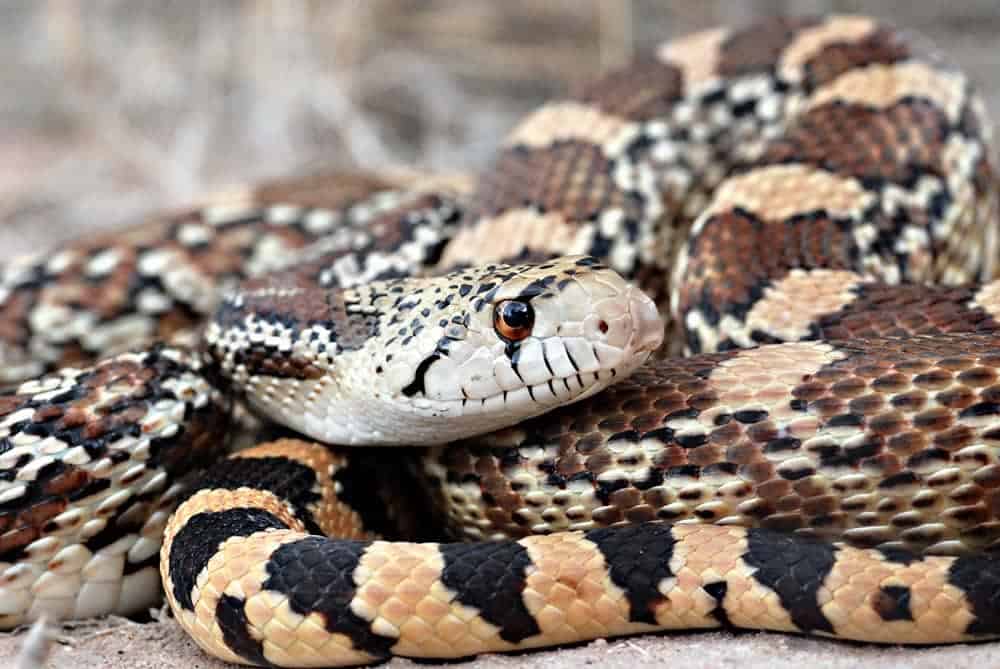
| Species: | P. catenifer |
| Longevity: | 12 – 15 years |
| Good to own as a pet?: | Yes |
| Legal to own?: | Captive-bred only |
| Adult size: | 37 – 72 inches (94 – 183 cm) body length |
| Diet: | Carnivorous |
Also called bullsnakes, this is the largest snake in Iowa. They prefer open, sandy areas, and their wild population is in decline due to habitat loss. Gopher snakes kill by constriction and have been known to breed with fox snakes on occasion.
22. Brown Snake
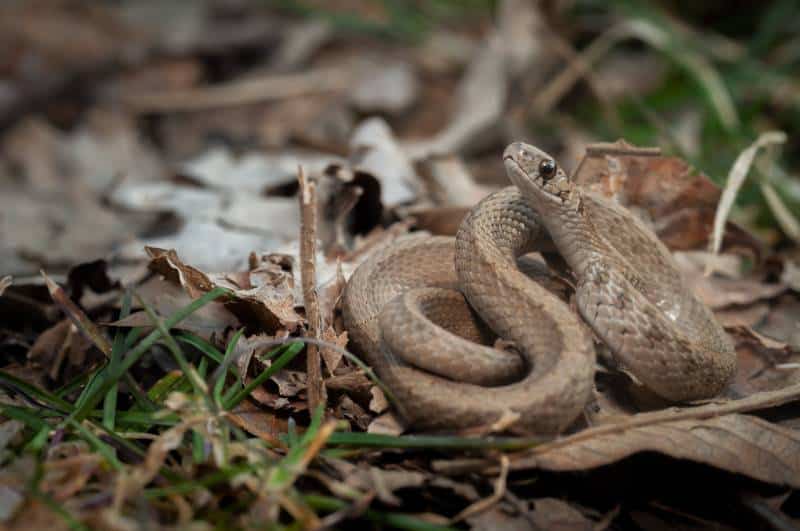
| Species: | S. dekayi |
| Longevity: | 7 years |
| Good to own as a pet?: | Yes |
| Legal to own?: | Captive-bred only |
| Adult size: | 13 – 18 inches (33 – 46 cm) |
| Diet: | Carnivorous |
A small brown or sometimes gray snake with a light stripe and a row of black spots down their back, these snakes like to live near water. They generally eat snails, worms, slugs. Quite adaptable snakes, they are often found in parks, city ponds, and backyards.
23. Red-bellied Snake
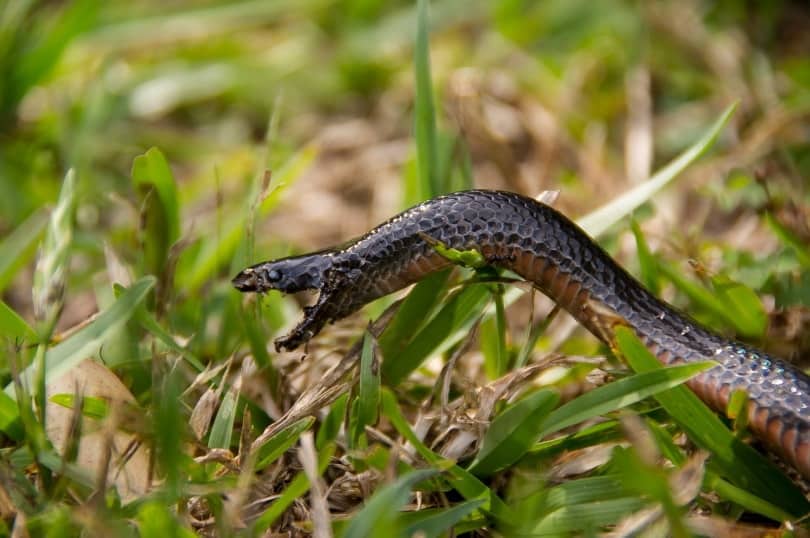
| Species: | S. occipitomaculata |
| Longevity: | 4 years |
| Good to own as a pet?: | No |
| Legal to own?: | Not in Iowa, protected |
| Adult size: | 7 – 10 inches (18 – 25 cm) |
| Diet: | Carnivorous |
Iowaʻs smallest snake species, Red-bellied snakes are either light brown or gray, sometimes with red stripes on their back. No matter the other color, they all have red or pink bellies. They live in wooded areas and primarily eat slugs and snails.
24. Western Ribbon Snake
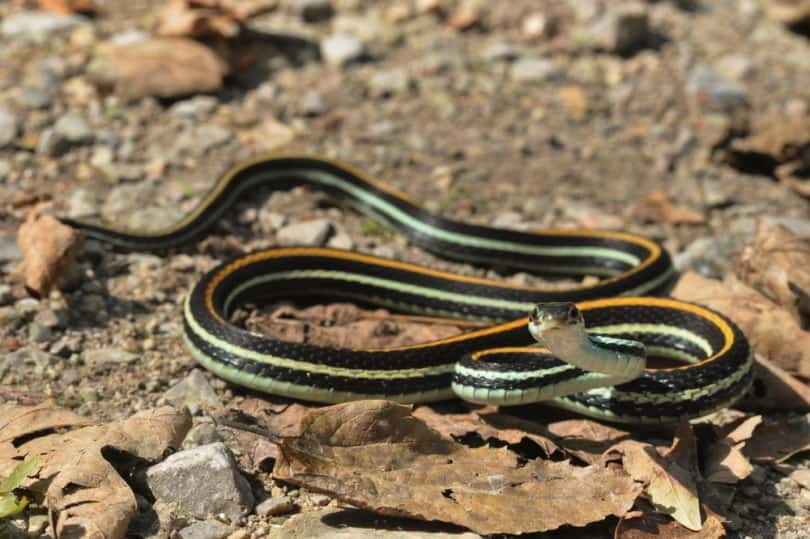
| Species: | T. proximus |
| Longevity: | 3 – 6 years |
| Good to own as a pet?: | Yes |
| Legal to own?: | Yes |
| Adult size: | 20 – 30 inches (51 – 76 cm) |
| Diet: | Carnivorous |
Western ribbon snakes are black with three orange and yellow stripes. They always live near water and are fast, athletic snakes able to climb trees or skate across the surface of the water. Fish, frogs, salamanders, and worms are their usual prey.
25. Plains Garter Snake
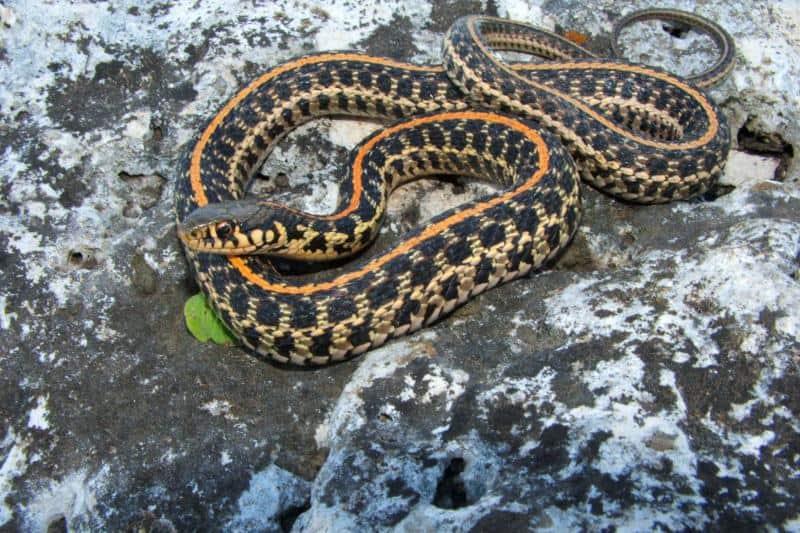
| Species: | T. radix |
| Longevity: | 4 – 5 years |
| Good to own as a pet?: | Yes |
| Legal to own?: | Yes |
| Adult size: | 14 – 43 inches (36 – 109 cm) |
| Diet: | Carnivorous |
One of the most widespread snake species in Iowa, Plains garter snakes live wherever they can find food and a place to sleep. They are adaptable enough to live within cities, making them one species often spotted by humans.
26. Common Garter Snake

| Species: | T. sirtalis |
| Longevity: | 4 – 5 years |
| Good to own as a pet?: | Yes |
| Legal to own?: | Yes |
| Adult size: | 14 – 48 inches (36 – 122 cm) |
| Diet: | Carnivorous |
The only species of snake that can be legally caught or killed in Iowa, Common garter snakes are found all over the state. Docile and often found living in backyards or parks, these snakes have huge appetites and will eat a variety of prey, including dead animals.
27. Lined Snake

| Species: | T. lineatum |
| Longevity: | 3 – 10 years |
| Good to own as a pet?: | No |
| Legal to own?: | Not in Iowa, protected |
| Adult size: | 8 – 10 inches (20 – 25 cm) |
| Diet: | Carnivorous |
Lined snakes are gray or brown, with three light stripes. They are shy snakes, found in prairies and backyards. Lined snakes prefer to hunt at night, mostly for earthworms and slugs.
28. Smooth Earth Snake
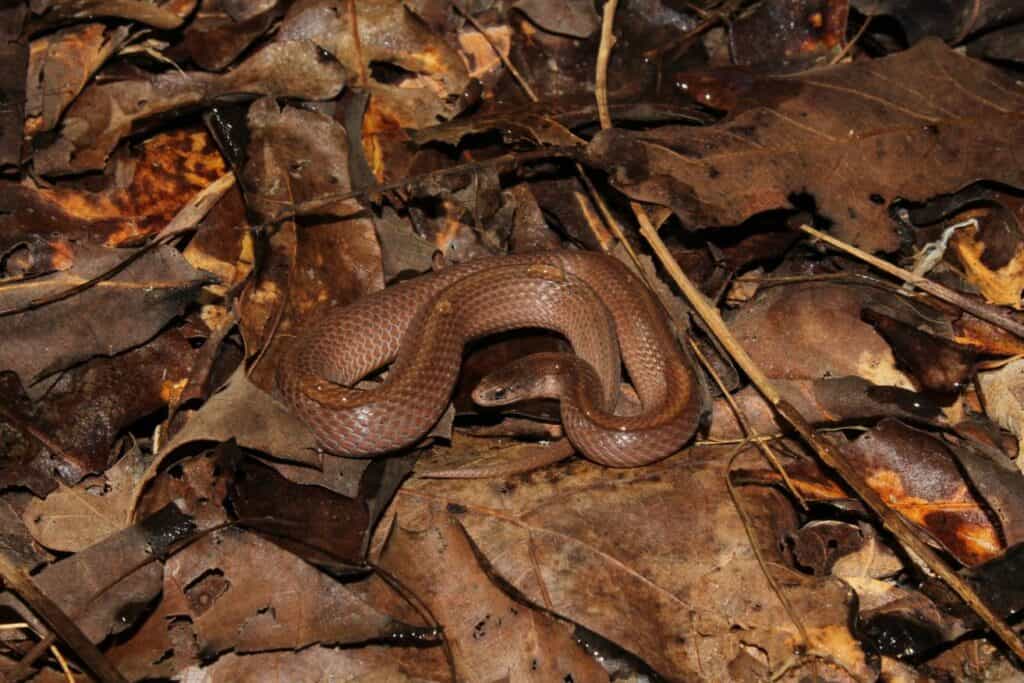
| Species: | V. valeriae |
| Longevity: | 9 – 15 years |
| Good to own as a pet?: | No |
| Legal to own?: | Not in Iowa, protected |
| Adult size: | 7 – 10 inches (18 – 25 cm) |
| Diet: | Carnivorous |
Smooth Earth snakes prefer moist wooded habitats, often near rivers or streams. This shy species is rarely seen and prefers to hunt earthworms at night.

Conclusion
Snakes are feared by many people, usually without just cause. In Iowa, there are only 5 venomous snakes, all with a limited range and low overall population numbers. Many Iowans may never see one of these 28 snakes but they serve a vital role in the health of local ecosystems.
Related Read:
Featued Image Credit: zoosnow, Pixabay
